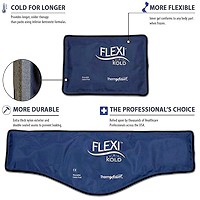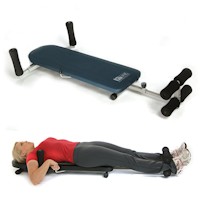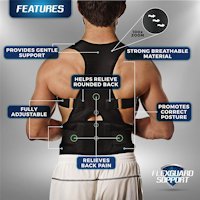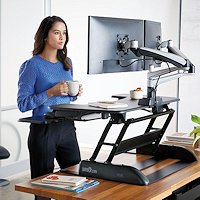Back Pain Advice For Managing Symptoms & Prevention
 If you’re suffering from back strain discomfort, don’t feel alone. A lot of individuals must deal with back discomfort every day. The back pain advice presented in the article below are created to help people treat a wide range of back discomfort conditions. You can make the decision to take proactive steps toward reducing your chronic back pain today.
If you’re suffering from back strain discomfort, don’t feel alone. A lot of individuals must deal with back discomfort every day. The back pain advice presented in the article below are created to help people treat a wide range of back discomfort conditions. You can make the decision to take proactive steps toward reducing your chronic back pain today.
If back injuries are something that you are prone to getting, either through genetics or lifestyle choices, make sure you see the chiropractor on a regular basis, even before the onset of pain. Serious back afflictions can often be avoided if you take care of small issues as they arise.
Back Pain Advice: Tip! Because you spend a good portion of time sleeping, it is important to use a comfortable mattress. Soft mattresses allow the back to slump into awkward positions and thus cause back pain. A very firm mattress cab be uncomfortable. Therefore, most health care professionals recommend a medium firmness.
Be certain your diet is healthy and nutritious and includes enough daily water intake. A nutritious and healthy diet can help prevent many health problems. A slimmer body can take the strain off the back, and drinking plenty of fluids can help detoxify the body to help stop back pain from occurring.
In order to prevent back pain, one of the best things that you can do is to never lift a box without knowing what is inside of it. You might not be prepared to lift what is in the box. Don’t rely only on the picture on the box, or what is written on the box to determine what is inside.
Stressing out about back pain only worsens it. Learning to relax is key, as it will decrease your chances of experiencing muscle spasms. Make sure that you get enough rest, and place moist heat onto your back in order to soothe any pain you’re experiencing.
Back Pain Advice: Tip! While waiting to get medical attention for an injured back, it is common to experience extreme discomfort while sitting down and lying in bed. If you are trying to get some rest while you wait for an appointment, consider laying down with your back flat on the mattress and your knees bent into a comfortable position. A pillow under the knees allows muscle spasms to relax.
When your back is hurting, you want to help yourself feel better and calm the spasms in your muscles. Applying heat, while lying down, is one of the best ways to relax your muscles. It is also a good idea to reduce how much sodium you eat and drink and instead drink a ton of water. Dehydration can actually cause or worsen spasms, so lots of liquids and minimal salt can be beneficial.
Many of the simplest methods of treating back discomfort are often the most effective. Just resting a few days can help. As you wait for relief, see if anti-inflammatory drugs such as naproxen, acetaminophen or ibuprofen provide any help. There are also some great traditional techniques like the alteration between hot and cold packs. They may not be modern, but they still get the job done!
If you have back pain, talk to your doctor so you can get a diagnosis. A knowledgeable doctor can run tests, review your medical history, get x-rays, and get to the root of the problem.
Back Pain Advice: Tip! A good fitness regimen could help you prevent back pains. For example, yoga increases your flexibility, which can help prevent straining any muscles.
Your Caffeine Intake
While it may be hard to believe, chronic back discomfort can be eased by drinking coffee. The caffeine found in coffee blocks the chemical adenosine. Adenosine stiffens your back, so drinking coffee will help ease muscle spasms and prevent pain. A 2016 review in Journal of Anesthesiology & Pain Medicine discusses the role of caffeine in pain management, especially migraines.
Back Pain Advice: Tip! Try not to stress the same muscle groups over and over again, regardless of the stance or position you may be in. Don’t make the same movements for a long time, even if you are cooking, cleaning or doing regular daily home duties or work tasks.
When sitting, always make sure you’re straight. Not sitting up straight strains your spine and back. If you are sitting for a long time, make sure you are using good ergonomics and sitting in a chair that is comfortable and supportive. Strengthen your posture and your core through the use exercises or appropriate activity.
Mind your posture at all times. Follow proper posture when sitting, including keeping your back straight, having both feet onto the floor and keeping your elbows level when you type. Avoid bending your neck down to view your computer screen.
Back Pain Advice: Tip! Practice retaining good posture, even when sitting, in order to prevent needless back pain. A lot of folks incorrectly assume that only rigorous physical actions serve as the cause of a back injury. Strain of bad posture over time can cause injury.
Sleeping on your stomach can cause a lot of strain on your back leading to pain in the morning. But sleeping on your side helps to distribute weight evenly. Make sure you have a proper support pillow for your neck to comfortably side sleep.
Effective back pain management is easy when you allow yourself to ask and accept help when it is necessary. You shouldn’t be ashamed in having someone help you lift and clean around your house. The key is to prevent yourself from aggravating your pain by performing unnecessary jobs.
A 2021 review in the Journal of Occupational Health indicates that working rotating and irregular shifts lead to an increase in back pain. For those who work, this may help stabilize the condition by stabilizing your work schedule.
A 2021 study in the Journal of Manipulative & Physiological Therapeutics indicates people with lower income perceive themselves as less able to manage their chronic back pain, even after taking into account factors like health insurance and educational attainment. The authors conclude, “There is a need to further investigate how practitioners and policymakers can best support low-income patients with chronic pain.”
There are a number of ways to treat that pain in the back. Some of the treatments described above may take a while to work, but when they do, you will notice the difference. A life without back discomfort is a happier life, so put the tips in this article to work for you.

 New Mattresses
New Mattresses Heat Therapy
Heat Therapy Cold Therapy
Cold Therapy Massage Tools
Massage Tools Relief Supplements
Relief Supplements Topical Relievers
Topical Relievers Traction & Inversion
Traction & Inversion Supports & Cushions
Supports & Cushions Belts & Corsets
Belts & Corsets TENS Therapy
TENS Therapy Posture Braces
Posture Braces Ergonomic Aids
Ergonomic Aids